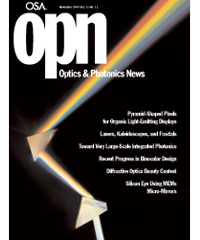
November 2000 Issue
Feature Articles
Pyramid-Shaped Pixels for Organic Light-Emitting Displays
Organic light-emitting diodes (OLEDs) arepromising candidates for the next generation of full-color flat panel displays. The advantages of OLED-based displays include full-color emission, a low level of power consumption, low-cost fabrication, high contrast, and potentially high lateral resolution. The pyramid shape pixel (PSP), a novel pixel structure for the integration of OLEDs in full-color organic emissive displays, offers the advantages of a full-color emissive pixel comprising individual red, blue and green (R- G-B) OLEDs with high resolution.
by Yang Yang and Shun-chi ChangLasers, Kaleidoscopes, and Fractals
Glance at the mode patterns of an unstable cavity laser and the immediate impression is of their beauty and complexity. Perform a detailed mathematical examination of their structure and one discovers that the patterns possess fractal character. We have christened the unstable cavity system as a kaleidoscope laser, after the device invented by Sir David Brewster in 1816. Just as the patterns in a toy kaleidoscope vary endlessly as the tube is shaken, so the modes of the kaleidoscope laser change with the shape of the defining aperture and the dimensions of the cavity (represented by the Fresnel number).
by G. H. C. New, G. S. McDonald, and J.P. WoerdmanRecent Progress in Binocular Design: The 8 x 56
Although binoculars have been on the market for more than a hundred years, at first glance it might appear that only minor changes have been made in their design. Outwardly they still look the same and they are still used in much the same way as they were 100 years ago. In reality, however, significant improvements have been made in areas including magnification, field of view, transmission, focusing, eye relief, and image quality. These improvements have led to decreases in volume, weight, and cost. After a brief review of the history of binoculars, I focus on recent improvements in lens design that have led to the appearance of new, attractive, and lightweight binocular designs.
by Walter BesenmatterSilicon Eye Using MEM's Micro-Mirrors
The Air Force Research Laboratory’s (AFRL) aggressive drive to reduce the size and weight of satellite systems for advanced space missions is providing a vital thrust to the development of systems-on-a-chip. Adaptive optics technologies offer tremendous potential in reducing the weight and cost of space-based optical systems. In addition to reductions in weight and cost, the adaptive optics techniques we present in this article offer advantages in size, speed, and performance. At the heart of these adaptive optic systems is a very large-scale integrated (VLSI) hybrid-wavefront reconstructor chip.
by Natalie Clark , Paul Furth

![A multiplexed image of a human tonsil acquired. [NIAID] using the iterative bleaching extends multiplexity (IBEX) method.](https://opnmedia.blob.core.windows.net/$web/opn/media/images/articles/2024/0424/departments/202404-cover-web.jpg?ext=.jpg)
